Preserving Fish in the Wild
Fishing is one of the easiest and efficient ways to get food when you’re in a survival situation. This means that having a way to preserve fish in the wild can allow you to keep that meat around for days, weeks, or even months.
How do you preserve fish in the wild? You can preserve fish in the wild using the following methods:
- Salt Curing
- Cold Smoking
- Hot Smoking
- Dehydrating or Sun Drying
- Freezing
- Keeping the Fish Alive
- Corning
There’s nothing worse than watching extra food spoil when you’re in a situation where you don’t know when your next meal is coming.
[wc_toggle title=“Table of Contents” padding=“” border_width=“” class=“” layout=“box”]
[/wc_toggle]
Preserving Fish
You’ve probably noticed that fish spoils extremely fast. In fact, some fish can actually go bad just minutes after it’s caught if you don’t take some action to preserve it. Even if you get your freshly caught fish into a fridge pretty quickly, it’s still only good for about two days.
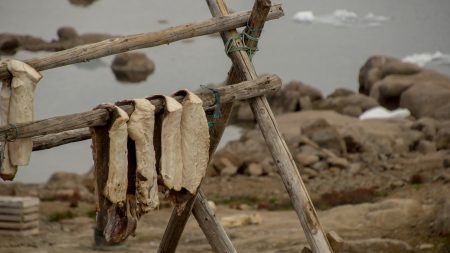
Why Do Fish Spoil so Fast?
Fish spoil quickly compared to something like beef. This is because of the temperature that fish typically live in.
Deepwater fish live in a temperature that’s barely above freezing and surface fish are still in water that almost never gets above 70 degrees! This means that the microbes that live in fish are also used to living in colder temperatures.
What’s the first way that people today use to keep food from spoiling? Cooling it down in the refrigerator.
When you put something like beef into the fridge, the microbes that are trying to break it down are uses to living at temperatures in the 90s. So a temperature in the mid 30s drastically slows them down.
When you put fish into the same environment, the microbes in them aren’t slowed down nearly as much and can continue to break down the proteins in them. You may notice that warmer water fish last for a little longer than other types of fish. This is why.
Fish also have very unsaturated fats, which helps when living in such a cold environment, that usually spoils quickly when exposed to oxygen.
How Preserving Fish Works
Moisture, light, microbes, oxygen, temperature, and enzymes all reduce the freshness and shelf life of meat. Preserving meat works by stopping or slowing the growth of microbes that lead to foodborne illnesses.
Once the meat is properly preserved, it can be transported, stored and used at a later date.

How to Salt Cure Fish
This may not be the most practical way to preserve fish in the wild, but it’s still an option if you happen to have access to salt. It’s also just a great technique for preserving food in general.
Begin by cleaning the fish as soon as it’s been caught or as soon as you remove it from the water if you’re keeping it alive on a fish stringer. Removing the guts, bleeding the fish and rinsing it in water gets a lot of the initial bacteria and microbes away from the meat.
Salt cure the fish following these steps:
- Clean the fish thoroughly.
- Filet the fish, leaving the skin on. This will help the fish stay together and can be removed when you’re ready to eat it.
- Place a layer of coarse salt into a covered container that will hold water and then a layer of fish, skin side down.
- Continue with layers of salt and fish until you’ve layered all of the fish that you plan on preserving.
- Make sure that you’re using plenty of salt on each layer. You want about 1 pound of salt per 5 pounds of fish.
- Place wooden planks (or another hard material) on top of the layered fish and weight them down to ensure your fish stays submerged in the brine that forms from the salt and water that’s removed.
- Keep the fish in your container for around 24 hours per inch of meat, checking on it at least every day. It should smell like fish and brine (like the smell of the sea). If there are any bad smells then there may be bacterial growth and you should consider throwing away the fish and starting over.
- The fish is ready when it is very firm to the touch.
The next step is to air dry the fish to remove the remaining water.
Follow these steps for air drying:
- Set up a drying area outside in an area with decent sunlight and airflow. This can be anything from metal grates to simply hanging the fish on low tree branches.
- Remove the filets from your container with the brine and rinse the excess salt off of the outside.
- After they’re rinsed, lay/hang them in your drying area. Bring the fish inside if it rains or snows.
- The fish will be ready when it’s as stiff as a board. Plan for at least 7 days of drying.
How Long Does Salted Fish Last?
Fish that don’t have a lot of oils will last nearly indefinitely. A good rule of thumb is to throw away the fish from last season when the new fish is ready. Plan on replacing your fish every 12 months.
Oily fish will still last for a long time but the oils can go rancid over time. If it smells off, then it probably is and shouldn’t be eaten.
If any moisture gets to the dried/salted fish it could go bad sooner.
Advantages of Salting Fish
Salt curing fish does two things. It removes the water from the meat making it a place that bacteria are less likely to inhabit and it also kills the bacteria itself by dehydrating them at the cellular level.
Salted fish can be easily transported and packed around so you have it when you need it.
Disadvantages of Salting Fish
Salted fish is REALLY salty! It usually takes several rounds of soaking and rinsing to get enough of the salt out to make it edible. This can mean wasting a lot of otherwise drinkable water which could be in short supply.
Salt curing requires a lot of salt, making it difficult to do in the wild unless you’ve been in one place for a long time and have been able to collect some salt or you bring a lot of salt with you.
Getting Salted Fish Ready to Eat
Salt cured fish has one major drawback compared to other preservation methods…all the salt.
Desalt the fish using these steps:
- Rinse the fish in clean water.
- Place the fish in a bowl of clean cool water for 12 hours.
- Rinse the fish again and soak it in clean water for another 12 hours.
- After 24 hours, the fish should be ready to cook. You can keep repeating this process to lower the salinity of the fish.
You should keep the fish as cool as possible while soaking it so that microbes and bacteria don’t have a chance to spoil the fish now that water is being introduced to it and salt is being removed.
A good alternative is to place the fish in cool running water (like a stream) to remove the salt. This will take less time but you need to be sure that nothing steals your fish. This has the added benefit of keeping the fish cool during the desalination process.

How to Get Salt in the Wild
Harvesting salt from the sea is probably the easiest way to get salt in large quantities. One gallon of seawater will give you around ¼ pound of sea salt.
You can either evaporate the water away by boiling or placing shallow containers in the sun and wind. Both will work depending on the amount of time that you have and the amount of wood you have for fires.
Something like a tarp laid out with seawater on it would make a good way to passively evaporate the water to collect sea salt.
Extracting salt from sand is possible if you’re in an area that contains a lot of salt in the sand. To extract the salt, you’re going to want to dissolve it in water and then separate the sand from the water.
The easiest way to do this is to place the sand into a container that will allow water to filter through it. Then, pour water through the sand and collect the water in another container.
Once you’ve collected the salty water, simply evaporate it off in the same way that you would with seawater.
Harvesting rock salt, brine springs, and salt lakes is the final way that will produce enough salt to be used in food preservation.
- Rock salt can be directly harvested from the ground if you’re lucky enough to be around an area that has a significant rock salt deposit. These aren’t really common, so it’s unlikely that you’ll have access to one.
- Brine springs are a little more accessible. They’re fed by water that flows through an underground source of rock salt. They’re not overly common either but if you happen to be near one, you can evaporate the water to collect salt.
- Salt lakes are another option. They can be treated like any other saltwater source and be evaporated down to collect the salt.
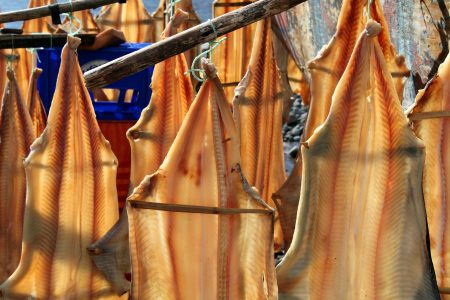
Dehydrating or Sun-Drying Fish
Dehydrating and drying fish is one of the oldest and simplest ways to preserve fish. This technique removes the water and makes it less likely that microbes will be able to spoil your fish.
Lean fish are the best candidates for sun-drying. Cod, halibut, bass, and sole are some of the best options. Even crabs, shrimp, and lobsters can be dehydrated, you just have to cook them prior to drying.
Fatty fish like catfish, lake trout, mackerel, mullet, rainbow trout, salmon and whitefish all have a fat content that is too high for traditional drying.
To dry fish in the wild follow these steps:
- Clean the fish thoroughly, removing the innards, skin, and heads. Once it’s cleaned, make sure it’s completely rinsed off.
- Fillet larger fish or leave very small fish whole.
- Cut the fillets into wide strips no more than ¼ inch thick. If you have access to salt, you can cover the fish with salt to aid in drying.
- The thin slices can now be laid out in the sun on improvided drying racks or hung from low branches.
- Monitor the meat to make sure animals and insects leave it alone. Some cultures set up a rotation to make sure the fish is monitored the entire time to keep flys off of it.
- Once the meat has a dry, jerky-like consistency, it’s ready to be stored.
You should store the dried fish in an airy area that is protected from animals and the weather.
Advantages of Dehydrating or Drying Fish
Sun-drying fish is probably the least labor-intensive of all of the preservation techniques.
It requires the least amount of set up, and the least amount of outside material.
Disadvantages of Dehydrating or Drying Fish
Sun drying is really only viable in warm, sunny weather.
Animals and insects can easily get to your fish as they’re drying. You have to keep an eye on them as they dry.
How Long Does Dried Fish Last?
Properly dried fish technically has a shelf life of up to several years. Make sure that you inspect any fish dried in this way before you eat it.

Freezing Fish
Freezing in the wild is a simple process if you’re in a very cold environment. As long as the weather stays below freezing, you can rely on it to keep your catch fresh.
Before you consider freezing there are two temperatures that you should keep in mind. An average refrigerator should be below 40 degrees. An average freezer should be at 0 degrees.
If you’re not sure that if the weather is going to stay near 0 degrees, then you probably can’t reliably freeze your fish. As the temperatures rise closer to 32 degrees, it becomes more and more likely that your fish will thaw and spoil.
Follow these steps when you’re going to freeze fish:
- Clean the fish thoroughly by bleeding, gutting and (optionally) removing the head.
- You should try to cover the fish in cloth or plastic if you have access to it then place it outside to freeze.
- If there is ice or snow outside, you should pack the fish in it to keep the temperature low and to aid in freezing.
Fish stored like this should be checked periodically to make sure that it hasn’t thawed or been contaminated by animals or insects.
Advantages of Freezing Fish
Freezing takes advantage of the weather outside so it doesn’t require very much work on your part.
Disadvantages of Freezing Fish
Freezing is only available if you’re in a very cold environment.
If the temperature rises too high the fish will thaw and spoil. This makes it one of the least reliable preservation methods.
Freezing fish in the wild doesn’t lend itself to easily transporting the fish if you need to move.
How Long Does Frozen Fish Last?
Fatty frozen fish like salmon will last 2 to 3 months. Lean fish will last up to 6 months when it’s frozen.
Smoking Fish
Smoking is the process of drying fish by exposing it to smoke. Smoking also preserves the fish by impregnating it with chemicals from the wood.
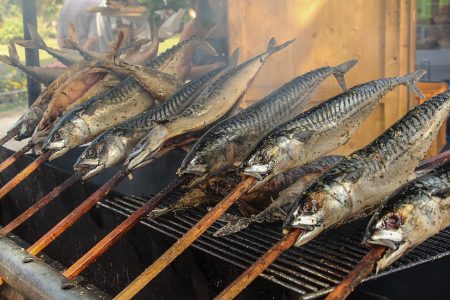
Cold Smoking Fish
Cold smoking is a process used to dry and smoke the meat without cooking it.
Follow these steps to cold smoke your fish:
- Gather non-conifer based wood to smoke the fish. Use apple, ash, hickory, mesquite, maple, and oak for the best flavor. You’re going to need to gather enough to keep a low fire going for quite a few hours.
- Start a low smokey fire with the wood that you’ve gathered.
- Fully clean, bleed, and gut your fish.
- Fillet the fish and cut the fillets into wide thin strips similar to how you would when sun drying.
- Rub the fish with salt if you have it and then suspend the fish above the fire high enough that it is in the smoke but the heat is not cooking the fish.
The fish is ready when it reaches a jerky-like consistency. Store the smoked fish in a dry place for use later.
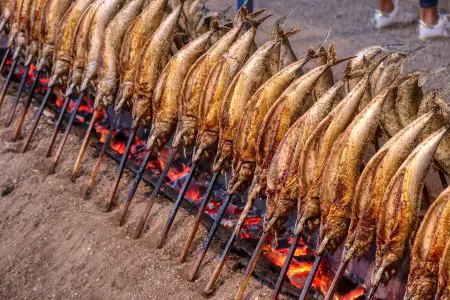
Hot Smoking Fish
Hot smoking fish is a cooking method where you use the heat of the fire to dry the meat, cook it, and smoke it. I prefer this method because it cooks the fish, preserves it and kills any possible parasites the fish may have.
Follow these steps to hot smoke your fish:
- Gather non-conifer based wood to smoke the fish. Use apple, ash, hickory, mesquite, maple, and oak for the best flavor. You’re going to need to gather enough to keep a fire going for several hours.
- Start a smokey fire with the wood that you’ve gathered.
- Fully clean, bleed, and gut your fish.
- You can either butterfly the fish or fillet it.
- Rub the fish with salt if you have it and then suspend the fish above the fire high enough that it is in the smoke and low enough to slowly cook it over a mild heat (around 140 - 180 degrees).
The fish is ready when it reaches a jerky-like consistency. Store the smoked fish in a dry place for use later.
How Long Does Smoked Fish Last?
Smoked and dried fish will stay fresh for longer than fish that is just dried.
It can last pretty much indefinitely if done properly and kept dry.
Advantages of Smoking Fish
Smoking adds a layer of smoke which contains chemicals from the wood (formaldehyde and alcohols) which are inhospitable to bacteria and other microbes.
Once smoked, fish will last nearly indefinitely.
Disadvantages of Smoking Fish
Smoking fish is difficult in some areas due to a lack of suitable wood.
You have to have enough wood for a fire that will last quite a few hours.
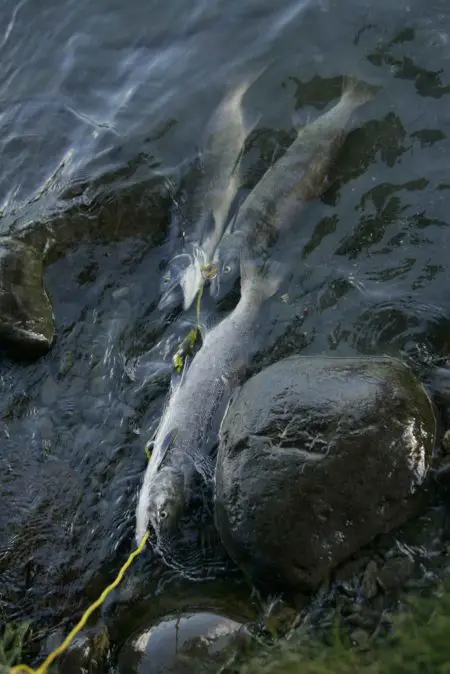
Keeping the Fish Alive for as Long as Possible
Keeping fish alive for as long as you can is probably the best way to preserve it. While the fish is alive, it’s not being broken down by the microbes and bacteria that cause it to spoil and there’s no need to take any kind of other special actions to keep the fish fresh.
Most fishermen keep their catch alive through the day while they’re fishing and then put them on ice once they’re headed home for the day. You can do this same thing in the wild.
Keep the fish alive for as long as possible so you can kill it and clean it right before you eat it or move on to a long-term preservation technique. You can use fish stringers to keep the fish alive while you’re fishing but they’re not the best for keeping your catch alive for a longer period of time.
In order to keep the fish alive for a longer period of time, you can build a pen of sorts to trap your catch in an area that allows them to swim freely but not escape.
Advantages of Keeping Fish Alive
Keeping the fish alive for as long as possible allows you to start other preservation techniques or eat them on your own timeline.
It doesn’t rely on the weather to keep the fish fresh.
Disadvantages of Keeping Fish Alive
You need to build a pen to keep the fish alive for longer than a couple of hours.
Even with a pen, they may not live for more than a couple of days.
Some fish are still likely to die even under the best circumstances.
Fish can’t be easily moved.
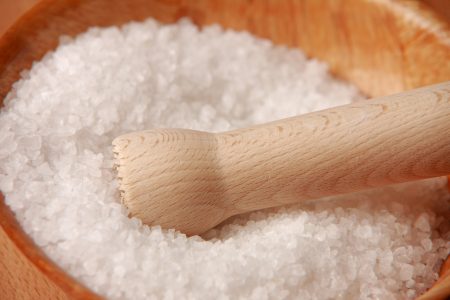
Corning Fish
Corning is a process that uses finely ground salt to preserve fish for up to 24 hours when the weather is warm. You’ll want to do this immediately so the salt can start drawing the water out of the fish and reduce the chances of spoilage.
Follow these steps:
- Gut, bleed and wash the fish as soon as possible.
- Pack the inside of the fish with salt (about 6% of the bodyweight of the fish).
- Place the fish in a container and cover in a damp cloth.
- The container should be kept out of direct sunlight if possible to keep the temperature of the fish as cool as you can.
Rinse the fish before you prepare it to get rid of the excess salt.
How Long Does Corned Fish Last?
When fish is properly corned it should last for 24 hours.
Advantages of Corning
The obvious advantage of corning is its ability to be used pretty much anywhere without any special tools. It’s also very fast compared to some other preservation methods.
Being able to be used when the weather is warm makes it a very flexible fish preservation method.
Disadvantages of Corning
Corning only keeps your fish edible for 24 hours so it isn’t going to let you stockpile large amounts of food for a long period of time.
What is the Best Method of Preserving Fish?
For me, the best method of preserving fish in the wild is hot smoking. It allows you to fully cook the fish, you can add salt if you have it and the smoke gives you an additional level of protection from microbes, bacteria, and parasites.
The best method in your area may be different. You should definitely try out several of the methods listed and see what works best for you!
The previous blog post The Complete Guide to Preserving Fish in the Wild was first published on: ready lifestyle
The Complete Guide to Preserving Fish in the Wild published first on https://readylifesytle.tumblr.com
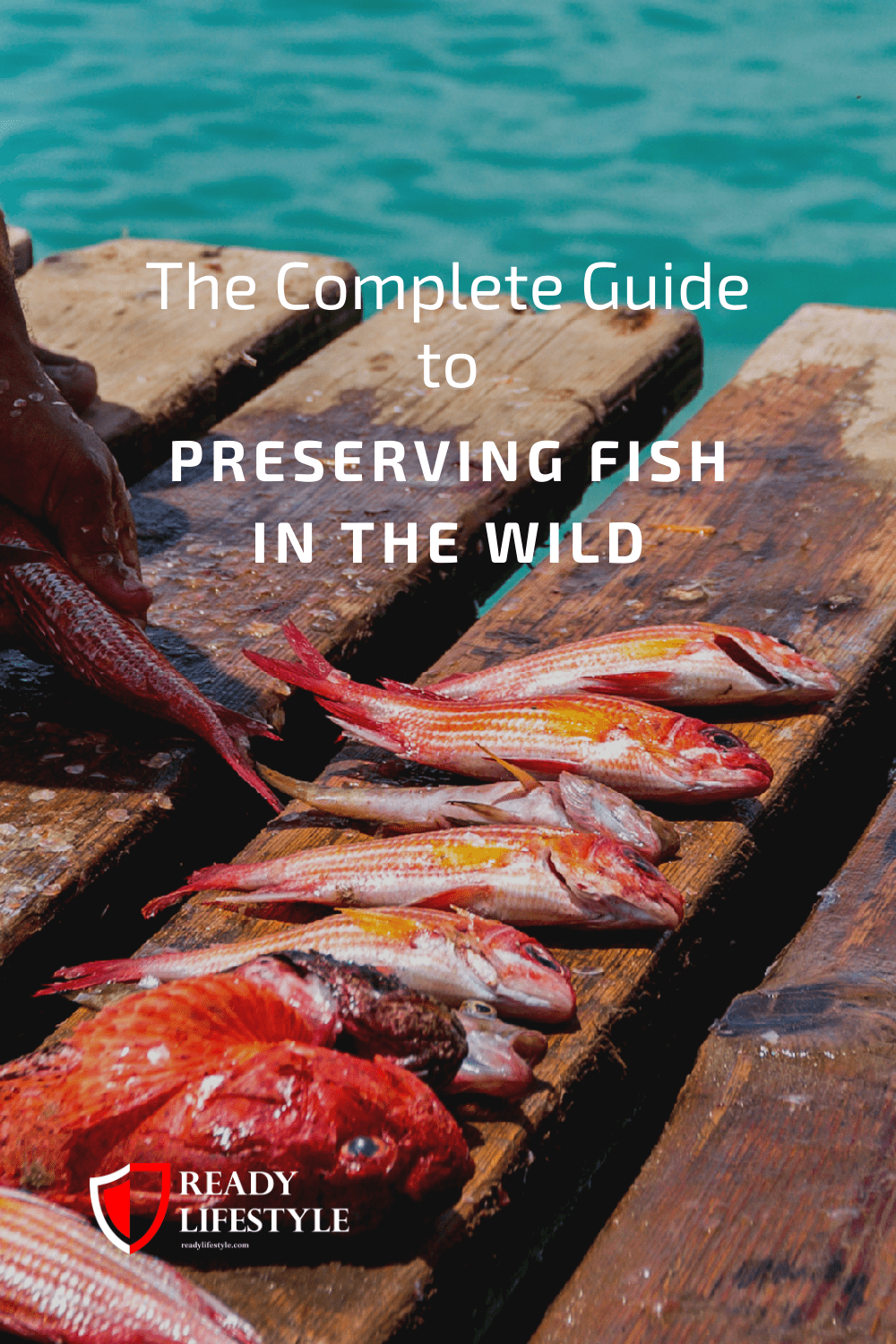
Comments
Post a Comment